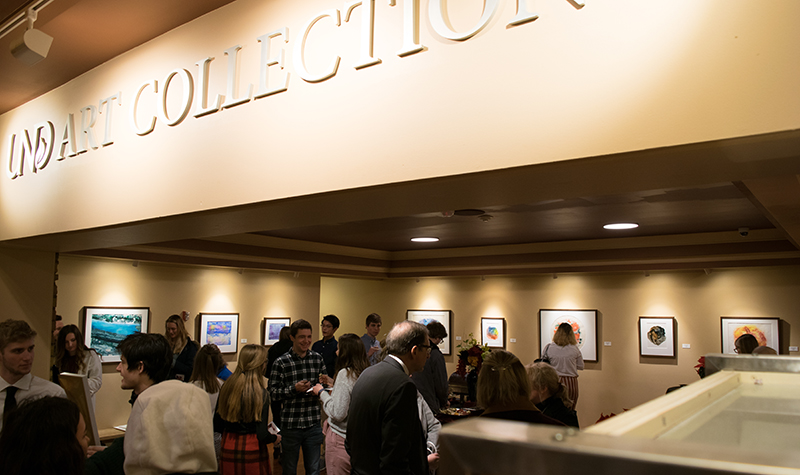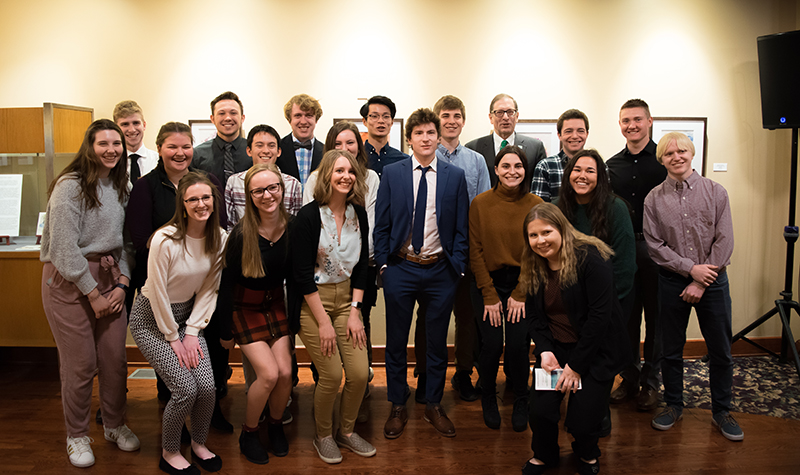15 Dec Exhibit celebrates former UND President George Starcher’s art
The student-curated exhibit showcases nonrepresentational art through Starcher’s monoprints

Put together by 19 students in Sarah Heitkamp’s Intro to Fine Arts class, a new exhibit at the Empire Arts Center explores the nonrepresentational monoprints of George Starcher, UND’s seventh president. Photo by Dima Williams/UND Today.
For about two decades at the helm of the University of North Dakota, then-President George Starcher, with his emphasis on faculty research and student satisfaction, steered the flagship institution toward its modern incarnation.
In the two decades that followed his retirement from UND, Starcher, a mathematician, devoted himself to art — snapping photographs, painting watercolors and creating elaborate monoprints.
The latter are the focus of the latest UND Art Collections exhibit — George Starcher: Untitled — at the Empire Arts Center in downtown Grand Forks.
The display, comprised of 19 pieces of kaleidoscopic bursts and uncanny forms, took shape in an honors course taught by Sarah Heitkamp, UND Art Collections manager and curator. This is the third exhibit Heitkamp has put together with UND students.
This semester, “once the students established criteria for their exhibition, and decided that this is what they wanted to do, I knew that was a great choice,” said Heitkamp. “It’s a great exhibition and the artwork is fantastic.”

The 19 students who curated the exhibit have no prior background in art. Photo by Dima Williams/ UND Today.
How the exhibit came together
Much like their peers from past semesters, the 19 students enrolled this fall in the Intro to Fine Arts class had little prior experience in art curation.
“Many of us had never even been to an art exhibition before, much less created one,” said Cassie Faul, a French, Spanish and secondary education major, in her remarks at the exhibition’s opening reception on Dec. 4.
In fact, none of Faul’s classmates is even pursuing an art degree at UND. Part of the rigorous honors program, Heitkamp’s course, though, complements any academic major because what she teaches transcends art to impart crucial life competencies.
“I would never have gotten the chance to do anything like this,” said Avery Breiland, a freshman studying political science. “The course taught a lot of leadership skills and how to communicate with a large group and how to really get something done in a timely matter. It was all real-world scale.”
What the students brought to the class, nonetheless, were their general interests. Some shared a fascination for Jackson Pollack, an artist famed for his tack of walking around outsize canvases and splashing paint on them. In class discussions, others found his creations quite bewildering, wrote Heitkamp in the brochure of the exhibit.
Those initial curiosities and confusions ushered the students to the nonrepresentational art movement of the 1960s and ‘70s from which Starcher likely drew inspiration for his monoprint works.
Without representation
Nonrepresentational art is hart to study, interpret and explain — mostly because it avoids realism to depict emotions and thoughts in patterns free of neat analyses.
The students had to not only make sense of Starcher’s monoprints for themselves but also convey their importance in an exhibit.
“As viewers, we can focus on certain elements of the work like the size and placement of lines and shapes, empty areas and textures, so we can come up with our own idea of what the work might mean,” said Gabrielle Miller, a junior studying athletic training.

Starcher often recycled handy materials for his art. Photo by Dima Williams/ UND Today.
Yet, Starcher, who was president of UND from 1954 to 1971 and who died in 1994, might be the sole person who truly grasped what the blocks of color and the swirls of shapes meant for Starcher the artist. His works bear no names, and the students offered no interpretations, aside from a single plaque describing the Golden Ratio in one of Starcher’s monoprints.
“The meaning will always differ between the viewer and the artist unless the artist reveals his or her true intentions,” said Miller.
Starcher’s secret meaning
In a glass vitrine at the Empire Arts Center, a postcard shows Starcher and his wife Margaret resting on two upholstered chairs, a fireplace burning behind them. Above the Starchers, the paper holds a “Greetings” message in pink, cursive letters and a superimposed aerial image of UND’s campus.
It looks like a regular postcard from the 1970s — until one flips it. On the back is one of Stacher’s monoprints, a seemingly fierce tangle of auburn strokes. For many of his works, the former UND president used recycled materials.
Some 200 of those “upcycled” canvases found their way to UND in 1995, a year after Starcher’s passing, through a donation from his estate.
For years, the artworks rested in The Elwyn B. Robinson Department of Special Collections at the Chester Fritz Library.
Earlier this year, when renovations of the department’s floor in the library building began, Heitkamp received a call. Would she want to take the Starcher portfolio?
“At UND Art Collections, we indeed want to preserve the University’s art and make it accessible to the public,” said Heitkamp. “We were excited to take the portfolio and document it and put it online fully. And then the students get to choose works for the exhibit.”
Split into five groups, the students had several weeks to research nonrepresentational art, learn about Starcher, select monoscripts, frame the pieces and pen a curatorial statement, among other tasks.

Heitkamp contributes to “Community,” an interactive project for the attendees of the opening reception last week. Photo by Dima Williams/ UND Today.
At the end, they also conceived a clever way to convey the multifaceted nature of nonrepresentational art. A blank canvas stood at the Empire Arts Center on Dec. 4 for attendees of the exhibit’s opening reception to paint. In an hour, it filled with lines and shapes and splotches and doodles.
The resultant artwork was decidedly nonrepresentational yet it encompassed the meanings of dozens of people.
Titled “Community,” it also bears an interpretation as a subtle nod to Starcher’s commitment as UND’s seventh president to elevate the University above the social tumult that roiled the nation’s higher education campuses during his tenure.
“We thought that creating nonrepresentational art would be a good way to wrap everybody together, so that everybody can contribute and really make it their own,” said Breiland.
If you go: ‘George Starcher: Untitled’ is on display at the Empire Arts Center in downtown Grand Forks through April 3.


